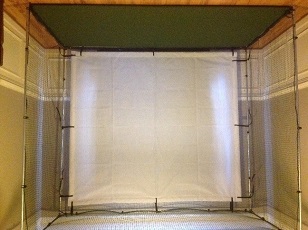How To Build A Golf Enclosure:
Spectrum Golf: Your Leader in Custom Golf Cages and Enclosures
At Spectrum Golf, we offer an extensive range of golf cages, golf enclosures, and golf frame systems that cater to every golfer’s needs and budget. Ready to take your indoor golfing experience to the next level? Let's explore our top-notch options!

Spectrum golf carries a wide variety of golf cages, golf enclosures and golf frames.
Lets review each one.
Basic 3/4"-1" Golf Cage
Pros:
- Budget-friendly
- Easy assembly and disassembly
Cons:
- Smaller screen
- Limited customization
- Exposed piping

Build Your Own Simple Golf Cage: Curious about how to make a golf hitting cage at home? The simplest solution involves using 3/4" or 1" EMT conduit from Lowe’s or Home Depot. Simply slide the EMT into the connectors, tighten, attach a four-sided net with ball bungees, and secure the impact screen with adjustable straps. It's basic but effective—the perfect DIY golf enclosure for the budget-conscious golfer!
Specifications:
- Depth: 60-120 inches
- Length: 10-15 feet
- Height: 10 feet
Customization Limitations: Due to their design, these golf cages offer limited customization options. However, you can enhance your setup with blackout panels, golf screen pads, and triangle floor pads.
_____________________________________________
Compact 14" Deep Screen Frames
Pros:
- -Space-Saving: Only 14 inches deep, perfect for tight spaces.
- -Freestanding: No need for additional support.
- -Full-Screen Size: Screen matches the full size of the frame.
- -Customizable Options: Can be made with or without sides and top, adjustable to your needs.
Cons:
- -Exposed Piping: Frame components are visible.
- -Height Limitation: Maximum height of 105 inches.

Ideal for Tight Spaces: Perfect for garages and basements, our 14" deep screen frame maximizes your screen size without taking up too much space. With a ceiling height of 9 feet, a traditional golf cage would limit you to an 8-foot screen. Our frame, however, maintains the full 9-foot screen height. This freestanding frame can be easily pushed against a wall when not in use.
Customization Options:
- Standard lengths: 120 and 144 inches
- Includes a back panel
- Optional sides and top panels, angled nets
_________________________________________________________
DIY Padded Golf Enclosure
Pros:
- -Padded for safety
- -No exposed piping
- -Quick and easy assembly
- -Durable poly spacer screen
Cons:
- -Requires separate purchase of conduit and pipe insulation

Build Your Own Padded Golf Enclosure:
Our latest innovation, the DIY padded golf enclosure, features heavy-duty Supertex material and a convenient three-piece design for easy replacements. The frame utilizes 3/4" EMT conduit wrapped in pipe insulation for added safety.
Key Features:
- -6" padding on top and bottom of the screen
- -Poly spacer screen for minimal bounce back
- -Made in the USA with superior quality control
Specifications:
- -Depth: 36, 60, or 120 inches
- -Length: 120 and 144 inches
- -Height: 96-120 inches
- ______________________________________
PROSERIES GOLF ENCLOSURE

Pros:
- -Fully padded
- -No exposed piping
- -Adjustable poly spacer screen
- -All-aluminum frame for durability
Cons:
- -Higher cost
The Complete High-End Experience!
The ProSeries golf enclosure is the ultimate luxury setup, coming 100% complete and assembling easily with simple hand tools. The frame is made of 1.5-inch squared aluminum for superior strength. The fully padded front captures errant shots, while the innovative elastic cord system allows for quick screen adjustments, minimizing bounce back.
Key Features:
- -Heavy-duty blackout Supertex material
- -Drop-down pad for high wedge shots
- -HD nylon support panel
_______________________________________
Design and Plan Your Perfect Golf Enclosure
Interested in designing your own golf enclosure? Fill out our REQUEST FORM to get started. Here are some things to consider:
- What are your dimensions?
- What system are you using? (Some require specific distances)
- Do you need side/top protection for stray shots?
- Permanent or temporary setup?
- How will you install the projector? (Ceiling, frame, floor?)
- Ceiling type: sloped or vaulted?
- Any obstructions like doors, windows, or ductwork?
- Lighting and ceiling fans overhead?
- Primary use: golf or movie screen?
- Noise level concerns?
- DIY frame or pre-built kit?
- Budget considerations? (Don’t forget to consult the spouse!)

Build Your Own Simple Golf Cage: Curious about how to make a golf hitting cage at home? The simplest solution involves using 3/4" or 1" EMT conduit from Lowe’s or Home Depot. Simply slide the EMT into the connectors, tighten, attach a four-sided net with ball bungees, and secure the impact screen with adjustable straps. It's basic but effective—the perfect DIY golf enclosure for the budget-conscious golfer!
Specifications:
- Depth: 60-120 inches
- Length: 10-15 feet
- Height: 10 feet
Customization Limitations: Due to their design, these golf cages offer limited customization options. However, you can enhance your setup with blackout panels, golf screen pads, and triangle floor pads.

